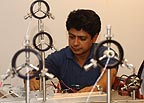July 11, 2007
SIUC scientist helps Caterpillar study ergonomics

Caption follows story
A scientist at Southern Illinois University Carbondale is developing technology that will allow companies to study a human's motion in such an environment in a much more accurate and timely manner.
Ajay M. Mahajan, professor of mechanical engineering and energy processes in the College of Engineering at SIUC, initially developed the 3-D ultrasonic location-finding system for use in brain surgery, where accuracy down to 1 millimeter is an essential standard. His system uses sensors on a surgeon's probe that transmit ultrasonic signals to an array of receivers, which can pinpoint exactly where the probe is in relation to the patient's brain in near real time.
Mahajan sought to enhance existing brain surgery systems, which rely on stereoscopic cameras and electronics to orient the surgeon. Such systems cost up to $750,000 and are subject to failure at crucial moments if a surgery team member, for instance, accidentally bumps the operating table or blocks the vision-based system.
Mahajan's system costs about 10 percent as much as existing systems and is more robust. He is working with the makers of current systems to find ways to interface his technology with the existing ones, improving its reliability and accuracy. His system also might work as a low-cost alternative to existing technologies.
But it also quickly became apparent that the system had other applications.
Caterpillar Inc. contacted Mahajan early last year about using the system to improve its ergonomics program, which examines how operators of the heavy equipment it manufactures move about in the driver's seat as they control the powerful machines.
To do this, the company also was using a stereoscopic-based system. It watched as an operator wearing a suit with brightly colored circles placed in key positions around the body — think Hollywood or video game digital animation — worked the machine. The system worked, but not as well as the company wanted. The accuracy was passable — it could detect positions to within about 1 inch — but the turnaround time between tests and actual data analysis took weeks.
Last summer, the Peoria-based company awarded Mahajan a grant to examine the feasibility of adapting the brain surgery technology to Caterpillar's needs. It didn't take long for Mahajan and his team — Haibo Wang, associate professor of electrical and computer engineering, doctoral student Sanjeevi Chitikeshi and undergraduate Chris Jenkins — to prove it would, even in the small, uncontrolled and often harsh environment of a tracked or wheeled front loader.
The system, which the team is building and testing in a lab at the Engineering Building at SIUC, uses a network of 15 ultrasonic transmitters sewn into a suit worn by the operator and 10 receivers placed at various points throughout the cab. Engineers can record the operator's movements within three dimensions to within about 1.3 mm during a test. They can then easily download the information into a computer, where it is filtered using error-correcting algorithms and organized with specialized software the SIUC team also is developing.
Ultimately, the Caterpillar engineers will have quick access to accurate data – a big improvement over their current tools.
Mahajan said the Caterpillar project has helped move the technology forward.
"Caterpillar has been a great blessing to us because it helped us take the technology in a new direction. We know now we can do it, we're just in the process of designing and turning this," he said, sweeping his hand over the area of his lab covered with wires, circuit boards and an array of transmitter/receivers that formed the Caterpillar test system, "into a set of simple black boxes. That's what Caterpillar will get when we are finished."
The system has great potential applications in many fields, Mahajan said, and he and SIUC will hold the patent on the system. But it was work he completed 10 years ago that made it possible.
Ultrasonic-based distance measurement had trouble with reliability back then. Mahajan, however, found a different formulation for estimating the speed of sound as it traveled to two different points — a sort of triangulation method. His approach brought the technology into the realm of practical application, which he then set about trying to find.
In cooperation with the SIU School of Medicine and the University's Biomedical Research Initiative, Mahajan also is working on a few biomedical devices. One is a diabetic footpad that uses sensors to measure the plantar pressure. The other uses novel absorbent materials for dialysis applications.
Caption:
Ultrasonic measurements – Ajay M. Mahajan, professor of mechanical engineering and energy processes at Southern Illinois University’s College of Engineering, works amid an array of ultrasonic transmitters and receivers at his laboratory on the SIUC campus. Mahajan is adapting a location-finding technology he developed for brain surgeons for use by heavy-equipment manufacturer Caterpillar Inc., which will use it to study how drivers interact with their machines.
Photo by Jeff Garner
